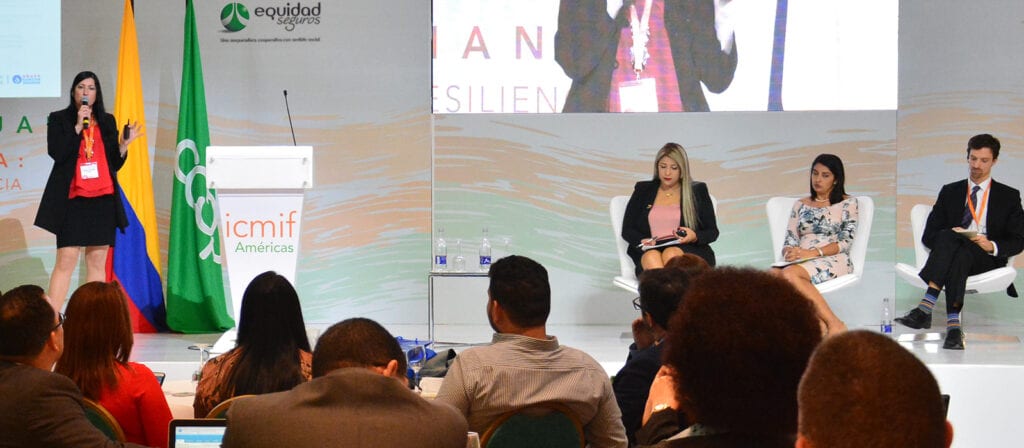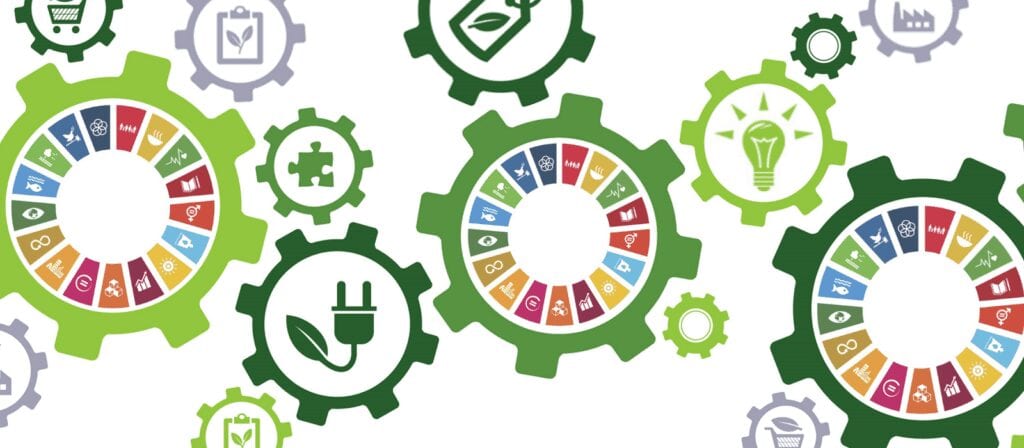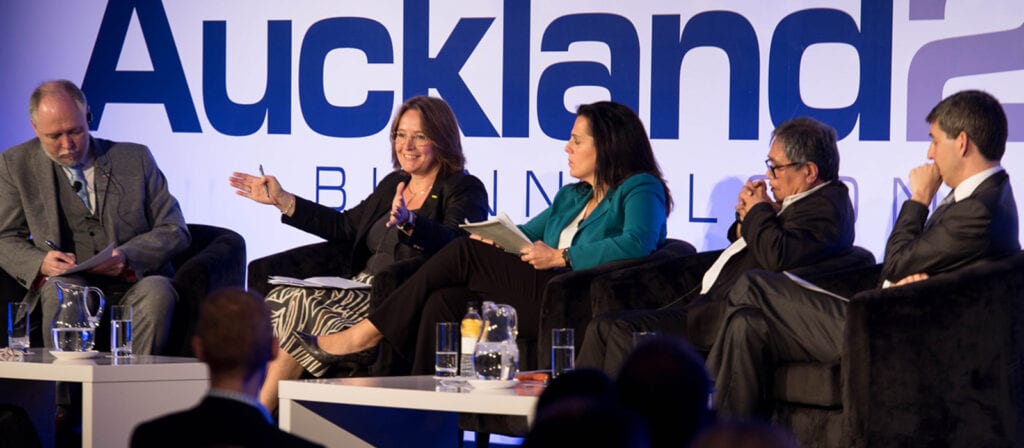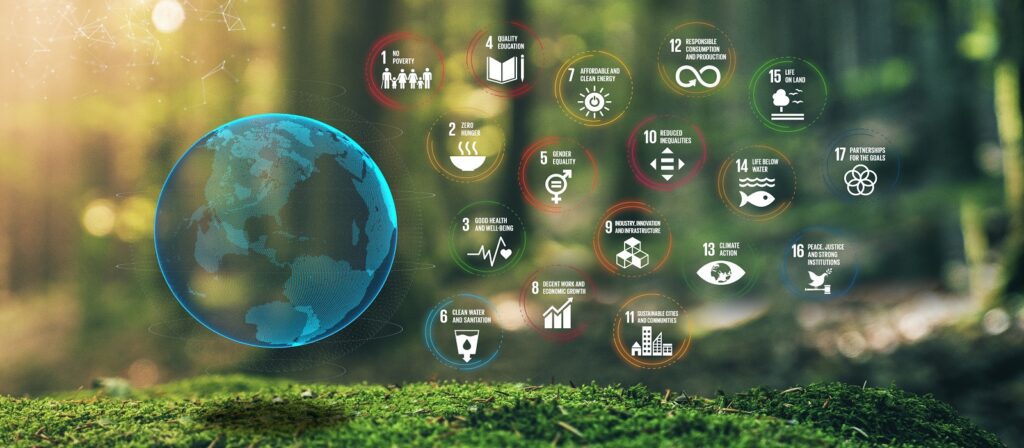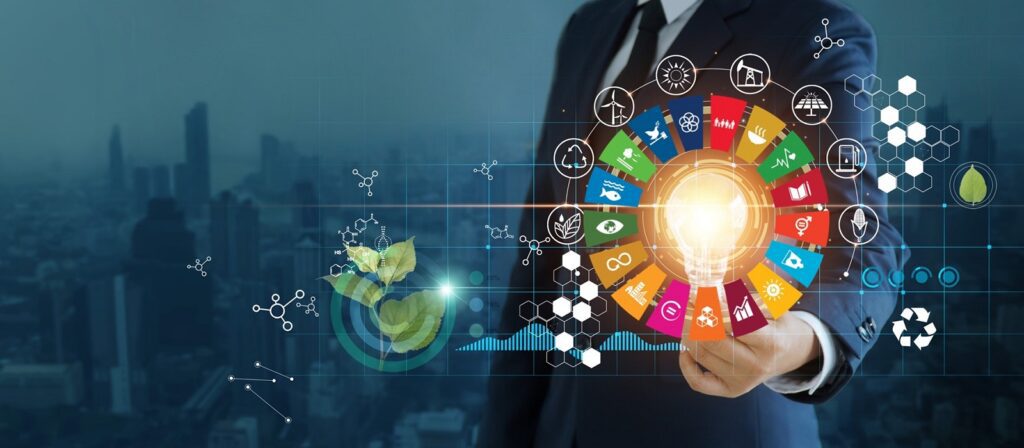Ben Telfer:
Hello everyone and welcome to today’s ICMIF webinar, “Integrating the SDGs into business strategy”. On today’s webinar we’ll be hearing from Betina Azugna. Betina is CSR manager at Grupo Sancor Seguros in Argentina. Betina will be presenting today on Sancor’s strategic approach to integrating the Sustainable Development Goals into Sancor’s organization and how they’re embedding sustainability across the organization and in their business strategy. Betina, thank you very much for joining us today and I’ll hand over to you.
Betina Azugna:
Perfect. Well hello everyone. On behalf of Sancor Seguros Cooperative I would like to thank especially to ICMIF for extending this invitation to share with you all of Sancor Seguros’ approaches to integrating the SDGs into our strategic thinking. I would like to thank all of you for attending this presentation. I hope you find my humble contribution useful. As you can see on the screen, I will be talking about the process we run to integrate the Sustainable Development Goals into the business strategy.
Let me introduce my cooperative. Its name is Sancor Seguros. We are seated in Argentina. Sancor Seguros was born 74 years ago in a little town of 25,000 inhabitants in the center of the country. Our headquarters is still based there. We have more than 7.2 million members, 3,300 collaborators. We are the leaders in the Argentina market with 11%. We are all over the country with more than 700 identified offices, 16 of them are our business units and almost 7,000 agents from another city to the end of the world. We have other companies, as you see, in Uruguay, Paraguay and Brazil. An insurance broker in Miami, a health company, an investment funds company, reinsurance company, a bank and a center of technological innovation.
It’s important to tell you that our portfolio is composed of 45% with workers’ risks, it’s one of the most important products; 39% of property; 10% of life and health insurance; and 5% of agriculture. However, with this 5%, we are among the leaders of the market.
Now I’m going to tell you briefly about our sustainability strategy. It has five cornerstones that guide our business and our process. First, you can see, we have the dialogue with the stakeholders to welcome all their expectations and integrate them to our business in a systematic way using an international standard, the accountability. This is the most important cornerstone we have, one of the most important, because we get a lot of things from it.
The second cornerstone is the innovation, the innovation and the development of sustainable products and services. When we talk about innovation, we mean new markets as micro-insurance or maybe products, innovations in prevention, for example.
The third cornerstone is the development in CSR initiatives, only related with our business. Our business is prevention, health and safety, so we always work with these CSR initiatives only related with these topics that are at the core of our business.
The fourth cornerstone is this generation of value. It’s related with our contribution of value to our influence sphere. For example, with our innovation center I mentioned before and our foundation, it’s objective, the objective of the foundation is maintaining and working with the cooperative principles. In that way, we are contributing and generating value to the community, to the group of interest.
Last but not least is the systematization and the economic, social and environmental performance measurement of accountability. This presentation is related to this cornerstone, because to achieve this, we must adopt, use, work with different tools or initiatives as the GRI Global Compact ISO 26000 and the SDG Compass. The SDG Compass, that is the tool we implement in order to contribute to the 2030 Agenda of SDGs. This presentation is mainly based on this tool.
Before that, let me present to all of you our main sustainability program. It’s called two words, Sustainable Citizen. Related to this, we have a dream. Sancor Seguros has a dream. We dream of a world with sustainable citizens. This sustainable citizen must have five dimensions for us, for an insurance cooperative. One of these dimensions is, as you see, the insurance awareness. Decent sustainable citizens have to be who are looking interested in insuring themselves, their families and the future of their kids.
They have to be worried about prevention, for example use the helmet, use seat belts and do not speak on their phones when driving. They have to take care of their domestic home accidents. If they own companies, it’s important that they implement the best practices of health and safety.
The third dimension is the health and wellbeing. We want a sustainable citizen who does regular physical activity, eats healthy, takes care of their health with medical checkups and avoids addictions.
Another relevant dimension is the ethics and integrity. We want a sustainable citizen who abides by the rules, do not commit or facilitate fraud, live according to the cooperative values, meet their commitments, don’t discriminate, include people.
Of course we look for a sustainable citizen who takes care of the environment. To help us to tackle the climate change, we want a sustainable citizen who adheres to our digitalization policy, uses our web tools, uses their resources responsibly and insure a sustainable destiny for their waste.
We work a lot in order to achieve this and it’s really, really related to the contribution to the SDGs, because our objective is we want all our stakeholders to be sustainable citizens, our board, the employees, our members, the suppliers, the agents, the community. We want all of them being a sustainable citizen. As I was saying, we work a lot and this is really, really related to the contribution to the SDGs.
Next I would like to go over the process, the SDG Compass step-by-step to show you how we work to integrate the SDGs in the business, to show you the SDG Compass and it’s five stages. Let me show you a quick overview so you can take a look at the five stages I’m referring to. Step one, understanding the SDGs, step two, defining priorities, step three, setting goals, step four, integrating the SDGs and then step five, reporting and communicating.
All of you know about the SDGs, I think. What are the SDGs? The Sustainable Development Goals of the United Nations to reach in 2030. Our board didn’t know about them in 2015. The first step was understanding the SDGs. The board, the directors, our CEO must know which are the SDG’s 17 goals and the 169 targets in order to identify the strategic goals for the business. The most important thing, the higher management, the CEO, has to show a strong commitment to this. For example, our former in 2015 was the president of the Argentinian UN Global Compact network. He was committed about the relevance of the 2030 Agenda and, obviously, of sustainable business. These are the stages, training and working with higher management, identification of strategic SDGs for the business, prioritization of SDGs and commitment.
Our CEO first evaluated the relevance of each SDG and categorized into: very strategic, strategic and less strategic for our business. We presented all of these in the monthly board meeting and the councillors and directors debated, voted and you can see on this line, on the next slide, the 11, 13 chosen SDGs. I said 11 because at first there were 11, but we had to add two more after. We have now 13. We identified seven very strategic goals and six strategic goals. After that, we chose the targets and we related them with the dimensions of the sustainable citizen, remember, and the cornerstone of the strategy I explained in the beginning.
You can see here the seven very strategic goals, the six strategic goals and an example of how we made the relation among the SDGs and targets with the material topics and the sustainability strategy. For example, you have goal number one, no poverty and poverty in all it’s forms everywhere, we chose the target to this goal number four and number five and we connected with the material business topics that are the sustainable citizen dimensions, health, insurance awareness and prevention and with the sustainability strategy cornerstones, prevention, safety and health, innovation and generation of value and so on.
I would like to point out this is a dynamic process. We run this process every year in Sancor. For example, last year, as I told you, due to some regulations and new products, we had to add two more SDGs. We only had, before that we had one, three, four, five, gender equality, decent work, reduced inequality, 11 the sustainable citizen, 12, 13 related to climate action, 16 and 17. We had to add two more. Because of some revelation we add to add number 15 and because of our innovation process, we had to add number nine.
Okay. Here we arrive to step two, defining priorities. We mapped all the value chain to identify areas of impact, selecting indicators, collecting the data and defining priorities. This is our different stages of step two. In order to effectively contribute to the sustainable development, it is necessary not only understanding the social and environmental impact of our business per se, but also the impact we have in our value chain. Throughout this and as a way to show our commitment with the SDGs, this world initiative, in 2016 and 2017 we have carried out an analysis mapping or tracing those links which are part of our value chain as you see here. These are the different links of our value chain. We then identified the positive and negative impact connected to the themes suggested by the SDGs. The last step, we identified those initiatives currently undertaken to contribute to the SDGs, classified into strategic and very strategic, we forgot the less strategic, in each link of the value chain. This classification was based on their focus, dividing them into mitigators of the negative impact, or boosters of the positive impact.
You will see in the next slide that we have here a chart with several columns where you can find each SDG, each target, then it’s actions as positive or negative impacts and last, the links in which the actions impact. In other words, the links, the specific place in the value chain where they impact. Based on those targets, we performed an in-depth analysis in order to understand their relevance and impact in our business.
This leads me to the next slide, which shows this relevance and impact matrix. In this relevance and impact matrix you can see the following variables. The Y axis shows the relevance, high, medium or low, which consists of the number of targets to which we contribute out of the total targets of that goal. The X axis shows the direct or indirect impact. We analysed all of these, all of this matrix and you can see that we have, in this place, which are the goals that have direct impact in our business and high relevance. Among these 13 goals, under strategic or very strategic, we had to choose again and we have these six SDGs that are more relevant than the others.
Okay. Next we have the third step, setting goals. Here you have to set specific measurable and timely met sustainability objectives. You have to do another thing, very important, you have to announce commitments with the SDGs, participation, workshops, anyway. This step three is very important because you have to establish the objectives and measure them. Here I can show you an example, a very specific example of our industry, the industry of SanCor Seguros with our more relevant goal. If you remember number three, goal number three was in the place with the more relevant goals in the matrix. This SDG number three is good health and wellbeing. You can see here, why is this very strategic? Because the development of initiatives linked to prevention, safety and health is part of one of the fundamental cornerstones of our strategy.
In Sancor Seguros we have seven labour medical centers, a pre-paid medicine company and an extensive development in health insurance. We said, okay, we are perfect to the SDG three. Our work is to create value according to our expertise in the scope of our business, so it’s very clear.
We know that it’s very strategic, but if we see, what sets the target? One of the targets of this goal, this goal has several targets, the target number 3.6 says by 2020, halve the number of deaths and injuries caused by traffic accidents in the world. You can see it’s the same target we have in our insurance business, so our contribution is direct, totally direct, because we are working all the time to reduce the accidents, to work for the health, the safety of our clients, of our employees and this is the same. We can contribute directly. All we do in order to achieve this is our contribution. We have a lot of figures we can handle and work on. What you see here are about our level of risk insured. If you see the percentage of insurance work it increased after four economic exercises, increased at 10%, but the growth of road accidents increased, but less, four percent and the deaths caused by road accidents decreased.
You can see here from 2015 we began with the SDGs until now, until 2019, the last numbers, we are almost reaching the goal, the objectives. We are almost contributed to reach, because we don’t have to say we have to reach the objectives or the goals, because we can’t reach the goals alone, we have to join with others. We only can contribute to reach the goal. You can, in whatever you choose, the objective you are working to reach or to contribute to reach, it’s for that, to contribute to reach the goals.
Let’s now turn to the actions taken in the last year, for example to get closer to the goal. These results I showed are because of something, are because of a lot of actions done by Sancor Seguros and by Prevención ART, the risk labour company. For example, in our labour risk insured we account for 367 risk advisors who visited almost 120 thousand companies last year and provided around 300,000 safety and health recommendations. We have a program for the prevention of traffic accidents in the work environment in which we provided on-site training for more than 10 thousand workers last year. We have a lot of actions to contribute to reach these goals and to reach these figures I showed before.
We count, for example on our road safety program, maybe with one road safety program or more for each stakeholder, including our own employees, brokers, community and future generations, let’s briefly take a look together here. We have, for employees for example, we have a program called Road Motivators program. With the suppliers we had road safety training. For the insurance brokers, they collaborate with us in the execution of different actions of their Routes in Red program, or I mentioned what we do with insured clients. With the community we had a national program for the prevention of traffic accidents called Routes in Red. It goes all around the country. With future generations, we have programs to children and to teenagers about road education. To the educational community we have a program called train the trainer targeting teachers and we work a lot with the government. You can see these in a day later or any time.
Another of the actions in step number three that I told you is announcing the commitments. You have to communicate them both inwards and outwards. We have here some examples about how Sancor Seguros announced their commitments outwards. We share our commitment to the 2030 Agenda in public and private SDG dialogues held in Argentina, in communication reports and in the previous sustainability reports. We participated in the call of companies made for the world business, for sustainability, development, the chapter in Argentina for the submission of initiatives that contributed to the SDGs. Our case was presented by the Global Compact in the progress report of Argentina, regarding compliance with the SDGs, at the meeting that took place in Mexico in 2017 and in other presentations, at the High Level Political Forum Business Chapter 2020 where I was virtually yesterday. This is a good example how we announce the commitment. We can, or you can announce the commitment in the way as you can, as you want, but you have to do it.
Inwards, we implemented workshops all over the country training more than 800 employees. We provided them with almost 2,000 training hours about the sustainability strategy, the CSR process, the Sustainable Citizen and the contribution to the 2030 Agenda. They work really a lot integrating all of these topics in these workshops. One of the most relevant things here is that, in each place, or business unit, a member of the board and the business unit manager actively participated. As I said in the beginning, the most important thing is the engagement of the high authorities, of the board, of the managers, of the directors. That gets the best results.
This leads me to the next step, integrating SDGs. The actions to implement here are anchoring the sustainability goals within the business operations, being sustainable in all of the functions, integrating sustainability objectives in areas and business units, committing in partnerships, value chain, industry initiatives, associations of multiple stakeholders. Those are the main topics in this step.
Let’s now look at the next slide, which shows you our global and integrating strategy. Here we have the sustainable citizen in the center of all, the five cornerstones of the sustainability strategy and the five dimensions of the sustainable citizen with a contribution to the different SDGs and all of these passed through by the Global Compact principles, the ISO 26000, all the seven core subjects impacting on each of our stakeholders as you see in the right side. This is our global and integrating strategy. Here you can see all of our processes and all the strategy in a summary form.
Next slide, here you can see the link among the business vectors and the cornerstones of the sustainability strategy. Here are the five cornerstones of the sustainability strategy and here are the five vectors of the business, profitable growth, relationship with the customer, efficiency in key business process, innovation, human capital. All of them are related with the five cornerstones and with the material topics.
The most important thing at this stage is evolution into sustainability KPIs aligned to the business. At Sancor Seguros we are working in the identification of a sustainability goal for each area, compliance and monitoring. These are our objectives. Formalization of CSR planning for business units, compliance and monitoring, we have CSR reference in all the countries who help us to reach these. Comprehensive analysis of 48 areas for which 103 preliminary objectives are proposed to begin working and so on, among others.
Here I have shared some examples of objectives by area. Let’s briefly go over this together. For example, we met with marketing, marketing management and we established with them these objectives to ensure that all campaigns, communication, messages comply with sustainability topics, establish a procedure to validate communication pieces with criteria of sustainability and prevention and safety, link the communication pieces, institutional and product to the concept of sustainability, develop in conjunction with the CSR management the inclusive communication axis of the inclusion program. We tried to choose objectives in common, objectives of this area, marketing management area, but with sustainability. We tried to integrate the sustainability in their objectives.
We didn’t mandate to them to create sustainability objectives, we asked them which were their objectives and we tried to integrate different lines of sustainability, different criteria of sustainability. We worked a lot with a lot of areas to try to manage that. For example, with the idea of management and publicity, the objectives were including environment, inclusion of sustainability in all events, et cetera.
Finally, the last step, reporting and communicating. It’s where your reports match with the core subjects of ISO 26000, with the GRI indicators and relating with the material topics. Of course previously you must have worked in the materiality matrix. Here you can see the materiality matrix of Sancor Seguros where you evaluate the business impact and the interest of the stakeholders. Here you have the most important topics, the material topics for Sancor Seguros to run these processes and this strategy.
In Sancor Seguros we’ve reported of our contribution to the 2030 Agenda and the SDGs since 2015. You can see here the four sustainability reports where you can find all we need in each step. Remember that you can move forward at your own pace through the different stages and steps. Going through step five each year, or each economic exercise for as many years as you need in order to contribute to reach the agenda. For example, in this, in the first sustainability report, we ran the step one and maybe the step two and the step five where you communicate the result. Maybe in the second report, in 2016, 2017, we ran step number one, two and maybe a little of, a part of three and we ran the step five and we reported. The same year by year, running every year the SDG Compass.
Well we are arriving to the last slide. This is the first page in our last sustainability report. Do you remember the six more important SDGs in the impact and relevance matrix? You can find these on the first page of the last report. It’s an example of how we present the different indicators with which we contribute with the most strategic goals. Remember the relevance and impact matrix. This agenda is really a challenge. You can see here which are the indicators to the goal number eight, to the goal number three. Oh, it disappeared. Here. I want to appear all the SDGs, but I had to click over on each SDG.
Here you have all the indicators for each goal, for example for goal number five you have 33% increase of women in executive and managerial positions comparing to 2005. 62.28% of the micro-insurance holders are women. Some indicators of goal number 13, a 35% increase in the portfolio of memberships of the digital coverage, 50% of the reduction of printing, 66% reduction of the safe drinking water consumption for irrigation in our corporative building and so on.
This agenda is a challenge for all. In all of us is the calling of working actively to contribute to achieve these world goals and targets. As António Guterres, the Secretray General of the United Nations, said, “We now have the chance to build back better than in the past and work together for a healthy, equitable, peaceful and more sustainable future for all.” In this way, we would be reaching the UN mandate of not leaving anyone behind.
In my last slide I would like to invite you to ask yourselves which is your goal? This brings me to the end of my presentation. I really hope this small contribution becomes valuable for you and thank you very much for your attention.
Ben Telfer:
Thank you very much, Betina. I’m sure that was a very valuable presentation for those in the audience, especially the five steps that you explained so simply, yet had such a comprehensive framework behind it. I think that was a very excellent presentation, so thank you for sharing today. We do have time just for a few questions, Betina, if you’re happy to answer them.
Betina, first question for you, can you give some examples of prevention initiatives at Sancor and have these been successful for the business?
Betina Azugna:
Yes. I have an example of our labour risk insurance company. For example, it has a program called Guide Companies. That program reviews the accident rate, frequency in a group of clients with specific characteristics, thus providing an improvement in the general indicators of prevention in the company. This program has a goal or an objective of minimal reduction rate of 10% in accident frequency in a representative sample. They do a lot of things, on-site training, training material and supporting brochures, so handouts and they have an online campus. They make a lot of action in order to prevent the accidents. They really have a lot of achievements because, with this program of prevention doing a lot of things and actions, they achieved a decrease in the accident rate for a representative sample, a percent of 15.91%.
They avoided accidents in a total of 1,432 and they said that the prevention of risk is an investment that favours all the involved parties, workers, employers and insurers, because the consideration cost investments … the most important thing here is the visit of the referent, the safe referent, the risk referent. He visits and gives recommendations, gives training, gives materials and works a lot with the workers. The consideration cost investment in this visit of this person, this engineer in risk is of 22 to one. This program, for example, that is based in capacitation, in training, in prevention very close to the worker, the insurance worker, gets a lot of results. Those are a lot of improvements to our company and to our employers, insurer employers and insurer workers. For example, we have this program. You can see directly the impact to the business and the impact on the people.
Ben Telfer:
Thank you, Betina. Another question. You briefly mentioned just at the end about Build Back Better, obviously a response to the pandemic. How has Sancor responded to the pandemic and has the response been your CSR framework?
Betina Azugna:
Yes. The answer to the pandemic from Sancor Seguros was very close to the CSR strategy because we react reaching all our stakeholders and in different ways of the core subjects and very, very related with the SDGs, very close. We work a lot with the governance, we created a crisis committee with directors and the management. This crisis committee works 24/7 adapting to the government decrees. The CEO sent a message to all the employees and to all the intermediaries, to the brokers, to keep them informed and provide them with calm and security and after that we began to make actions with all the stakeholders, employees, with the [inaudible 00:49:05], 100% of the personnel and we set up a new communication channel. We gave courses to develop digital skills.
The most important thing we do at Sancor Seguros, we pre-paid Prevención Salud own a telemedicine service called “Call the Doctor”. It’s a virtual doctor that refers qualified and immediate medical services by video calling available 24 hours every day of the year. It’s access is open for those who have the higher health coverage, career insurance or Prevención Salud pre-paid. This service, from the COVID situation we made available for every independent worker, for every employee, despite the fact they have coverage or not, only the DNA is needed to access this service. Watching this from the eye of the sustainability, we gave this service to our employees, to all in a free way to all employees, to all our brokers, to the most of our insurance clients of our members, because we extended it to another insurance product and we extended to all the community of Sunchales where is the headquarters of Sancor Seguros.
We worked a lot in a sustainability way to react to this pandemic situation with a lot of actions. That is one, that is the best example, because with the same action we reach all the stakeholders, community, clients, employees, brokers and included here are the ex-workers of the company. We made, we launched a corporate voluntary program so we gave them this service and other types of containment for this situation. We reached all the stakeholders with this. The COVID situation has a lot of … we had to do a lot of things in this situation, several of them are related with the SDGs.
The effect of the COVID-19 pandemic, for example, could reverse the limited progress that has been made on gender equality and women’s rights, so we have to work about this. We have a diversity committee and we are dealing there with some actions we want to do. Because of this, because women play a disproportionate role in responding to the virus, including as frontline healthcare workers and career-less at home women, unpaid care work has increased significantly as a result of school closures and increased needs of other people, there are a lot of problems which COVID carry out and we have to deal with these in the company. We did it, we did a lot of things with … I mentioned one, we did a lot more things, but we have still to keep working because the COVID, the pandemic has a big, big impact of different topics very related with the SDGs and the sustainability strategy and the sustainability topics.
Ben Telfer:
Absolutely. I know that ICMIF published a news story about Sancor’s response on our website, so if anybody would like to learn more about how Sancor’s responded, please check out that news article. Betina, I think we’ve got time for one more very quick question and it’s just asking whether your sustainability reports are available on your website?
Betina Azugna:
Yes, they are available at www.gruposancorseguros.com. There you can find the 14 sustainability reports, because we began the process in 2005. The last is the most important because it has all the stages I was mentioning today and it’s very interactive. The problem is that it’s in Spanish. We will try to make a translation, a summary translation in English in order to publish in English our accountability.
Ben Telfer:
I’m sure that’d be very valuable to other ICMIF members. I think we’re going to close today’s webinar. Thank you, Betina, for an excellent presentation again and for some great discussion. Thank you everybody for joining. Goodbye.
The above text has been produced by machine transcription from the webinar recording. ICMIF has made every effort to ensure that transcriptions are as accurate as possible, however, in some cases some text may be incomplete or inaccurate due to inaudible passages or transcription errors. Listening to or watching the webinar recording will allow you to hear the full text as delivered during the webinar but this is available in English only. Our transcriptions are provided to enable members to select the language of their choosing using the dropdown menu above.
